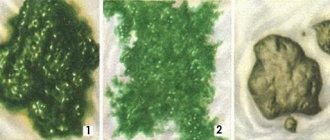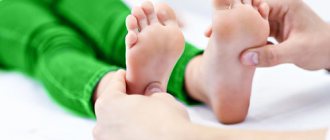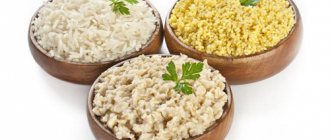Abnormal stool in a child
In childhood, bowel dysfunction is the most common reason for visiting a doctor. In children, gastrointestinal disorders may manifest as diarrhea, constipation, or fatty stools.
In childhood, bowel dysfunction is the most common reason for visiting a doctor. In children, gastrointestinal disorders may manifest as diarrhea, constipation, or fatty stools.
Parents need to remember that a child’s bowel movements may indicate serious illnesses, which means they should immediately contact a gastroenterologist who will identify the causes of the disorder and prescribe adequate treatment.
Causes
Fats (lipids) from food are digested in the intestines under the action of the enzyme lipase, produced mainly in the pancreas. Congenital lipase deficiency sometimes occurs , but in newborns this deficiency is more often temporary, associated with immaturity of the pancreas . As a result of this immaturity, the production of enzymes, including lipase, is insufficient. This deficiency occurs especially often in premature infants and children with intrauterine growth retardation.
Meanwhile, nature has foreseen this situation and provided babies with reliable insurance: breast milk contains lipase, which facilitates the digestion of fats. However, if the baby is formula-fed, pancreatic lipase immaturity may manifest itself clinically.
In addition to lipase, a certain composition of bile is required for the digestion of fats, so disorders of fat metabolism can also be observed in children with diseases of the liver and biliary tract . Such diseases are characterized by not just fatty, but also lighter-than-usual stools.
Diarrhea
Most often, diarrhea in children occurs due to intestinal infections. An increase in incidence is observed in the summer. In young patients, diarrhea may be accompanied by nausea, vomiting and fever. In case of an acute attack of diarrhea, you must immediately show the child to the doctor. It is important to contact the nearest medical center that provides medical care for children.
Such a center is a children's medical center, which is located in the village of VNIISSOK (Odintsovo district, residential complex "Gusarskaya Ballada"). Since it is very important to see a doctor in the first hours of a child’s illness, especially when the body temperature rises, residents of Odintsovo can call a doctor at home for a timely examination of the baby.
Diagnosis and treatment
If a child has fatty stools, which is accompanied by constipation or diarrhea, a pediatrician or pediatric gastroenterologist will first rule out problems with fat digestion. For this purpose, a scatological examination is prescribed (i.e., stool examination), and the condition of the liver and pancreas is checked (ultrasound, biochemical and immunological studies).
In difficult cases, the child is examined in a hospital. Children are given a diet and medications containing pancreatic enzymes and bile acids. Treatment is prescribed only by a doctor, since the composition and effectiveness of enzyme preparations are different, and there are certain indications and contraindications for them.
Constipation
Many parents do not pay enough attention to constipation in young children. After all, with constipation, there is no dehydration of the body, there is no loss of useful microelements and vitamins, as with diarrhea. However, constipation, especially frequent, may indicate many diseases of the gastrointestinal tract.
To ensure that these diseases do not cause irreparable harm to the baby’s health in the future, parents need to show the baby to a specialist. A gastroenterologist will quickly determine the causes of the disease and prescribe appropriate treatment, which is most often limited to a special diet and the introduction of certain foods into the child’s diet. Medications may also be prescribed.
Celiac disease
One of the most serious causes of fatty stools is celiac disease.
Celiac disease is a genetic disease in which, due to enzyme deficiency, the absorption of a substance called gluten is impaired. Gluten is found in many grains and is included in many foods. When consuming such products, toxic products of incomplete breakdown of gluten accumulate in the body of a patient with celiac disease, which damage the mucous membrane of the small intestine. This damage is accompanied by impaired absorption of proteins, fats and carbohydrates, and the development of the so-called malabsorption syndrome.
As a rule, symptoms of celiac disease first appear in children some time after the introduction of cereals (semolina, oatmeal and other cereals) into the diet. This causes diarrhea and fatty stools. Such children grow poorly and gain weight, becoming capricious and irritable. Over time, symptoms of rickets may appear.
Fat stool
Fatty stools can occur both with diarrhea and with constipation in a child. If your baby has feces that are difficult to wash off the walls of the potty or toilet, and also leaves greasy, stubborn stains on diapers or panties, you should urgently seek advice from a pediatric gastroenterologist. The doctor, first of all, must rule out problems with the digestion of fats contained in food and determine the cause of this disease.
To do this, the child is prescribed an examination, which is most often carried out in a hospital. Based on the examination results, the doctor prescribes adequate treatment, which includes a certain diet and medications.
Medical specialists strongly recommend contacting qualified doctors for any bowel disorder in children. This is due to the fact that the child’s body cannot fight many disorders on its own, and uncontrolled self-medication can aggravate the situation, and in this case, treatment can take a long time. Remember that a child's stool is an indicator of his health.
Date of publication: 12/13/2018 17:05:15
Celiac disease treatment
The main treatment for celiac disease is a diet completely eliminating foods containing gluten. All grains should be excluded from the diet, except rice, buckwheat, corn, as well as products that may contain them, including sausages, sausages, and some canned food. Usually the diet is supplemented by eliminating lactose and allergens.
Children 1 year of age may be prescribed soy formulas or formulas based on casein hydrolyzate.
In case of celiac disease, adherence to the diet should be lifelong, since departure from it is not only fraught with a possible exacerbation of the process, but significantly increases the risk of developing malignant neoplasms, including intestinal lymphomas.
Strict adherence to the diet with timely initiation of treatment helps ensure the normal development of the child. In case of strict adherence to the diet and adequate additional therapy, children with celiac disease do not lag behind their peers in either physical or mental development.
Everything you need to know about a child’s stool: a complete educational program from a pediatrician
There are hardly any parents who would never ask questions or worry about their child’s bowel movements. After all, jokes about “we pooped” and the baby with a “hard gray hair” did not arise out of nowhere. We will understand this delicate issue together with a neonatologist, pediatrician, Ph.D. Irina Igorevna Lavrenuyk @doctor_lavrenuyk.
So, what should a child’s stool normally look like?
Color
Can be anything: brown, yellow, gray-green, variegated (multi-colored in one serving). If your child starts eating complementary foods and your stool turns the color of the pumpkin or broccoli you ate, this is normal. White stools should alert you - this may indicate pathology of the liver and gallbladder. Red stool – fresh bleeding (for example, due to an anal fissure, intestinal diseases, etc.). Black stools can mean old bleeding if the stomach or small intestine is damaged. Beetroot, activated carbon, iron supplements, and foods with dyes can also color a child’s stool - don’t panic right away and remember what the child ate in the last 2-3 days. If you see not just streaks of blood, but bleeding from the anus, call an ambulance immediately. In other cases, if small traces of blood are detected in the stool and the child is feeling well, show him to the pediatrician as planned.
Consistency
If the baby is breastfed, the stool is usually soft and mushy. When artificially fed, it is denser. The consistency may vary throughout the day. If you see “white” granularity in the baby’s stool, water spots, a small amount of mucus without lumps, this is also normal.
With the introduction of complementary foods, feces become formed. The smell turns from sour milk to unpleasant.
Frequency
Comfortable stool frequency varies from person to person. When breastfeeding, stool is allowed once every 7 days. With artificial feeding - twice a week. Although in my practice I have not met children who felt great during 7 days without bowel movements. If the child begins to have stomach discomfort after fewer days, or constipation occurs, there is no need to wait for this period!
Constipation
With constipation, the longer the stool is absent, the denser it becomes. Sometimes it becomes so dense that the child can no longer go to the toilet on his own. Some babies experience constipation BEFORE the introduction of complementary foods, others – after. This means that the baby poops:
- Rarely (less than 2 times a week)
- Difficult (pushes very hard, at this moment it may hurt him)
- Discomfortable (episodes of fecal incontinence, large stool masses, no feeling of satisfaction after passing stool)
We talk about constipation as a problem if two or more of the listed symptoms occur within 1 month.
IMPORTANT! Most often, constipation is confused with infantile dyschezia (difficulty in defecation due to lack of coordination between the pelvic floor muscles and anal sphincters). With dyschezia, the baby will also blush, strain, and worry. BUT! Stools with dyschezia will always be soft.
Sources
- Oluwagbemigun K., O'Donovan AN., Berding K., Lyons K., Alexy U., Schmid M., Clarke G., Stanton C., Cryan J., Nöthlings U. Long-term dietary intake from infancy to late adolescence is associated with gut microbiota composition in young adulthood. // Am J Clin Nutr - 2022 - Vol113 - N3 - p.647-656; PMID:33471048
- Ye Q., Wang H., Xia X., Zhou C., Liu Z., Xia ZE., Zhang Z., Zhao Y., Yehenala J., Wang S., Zhou G., Hu K., Wu B ., Wu CT., Wang S., He Y. Safety and efficacy assessment of allogeneic human dental pulp stem cells to treat patients with severe COVID-19: structured summary of a study protocol for a randomized controlled trial (Phase I / II) . // Trials - 2022 - Vol21 - N1 - p.520; PMID:32532356
- Stallings VA., Tindall AM., Mascarenhas MR., Maqbool A., Schall JI. Improved residual fat malabsorption and growth in children with cystic fibrosis treated with a novel oral structured lipid supplement: A randomized controlled trial. // PLoS One - 2022 - Vol15 - N5 - p.e0232685; PMID:32384122
- Turkalj M., Matišić V., Šimić A., Juginović A., Erceg D., Tješić Drinković D., Höppner W., Primorac D. Cystic fibrosis presentation in del. F508 and p. Tyr109Glyfs compound heterozygote CFTR state: a case report. // Croat Med J - 2022 - Vol60 - N3 - p.246-249; PMID:31187952
- Stallings V.A., Sainath N., Oberle M., Bertolaso C., Schall JI. Energy Balance and Mechanisms of Weight Gain with Ivacaftor Treatment of Cystic Fibrosis Gating Mutations. // J Pediatr - 2018 - Vol201 - NNULL - p.229-237.e4; PMID:30029855
- Ikuse T., Kudo T., Arai K., Fujii Y., Ida S., Ishii T., Mushiake S., Nagata K., Tamai H., Toki A., Tomomasa T., Ushijima K., Yanagi T. ., Yonekura T., Taguchi T., Shimizu T. Shwachman-Diamond syndrome: Nationwide survey and systematic review in Japan. // Pediatr Int - 2022 - Vol60 - N8 - p.719-726; PMID:29804317
- Patni N., Quittner C., Garg A. Orlistat Therapy for Children With Type 1 Hyperlipoproteinemia: A Randomized Clinical Trial. // J Clin Endocrinol Metab - 2022 - Vol103 - N6 - p.2403-2407; PMID:29659879
- Zavala GA., García OP., Camacho M., Ronquillo D., Campos-Ponce M., Doak C., Polman K., Rosado JL. Intestinal parasites: Associations with intestinal and systemic inflammation. // Parasite Immunol - 2022 - Vol40 - N4 - p.e12518; PMID:29364525
- Gianni M.L., Roggero P., Baudry C., Fressange-Mazda C., le Ruyet P., Mosca F. No effect of adding dairy lipids or long chain polyunsaturated fatty acids on formula tolerance and growth in full term infants: a randomized controlled trial. // BMC Pediatr - 2018 - Vol18 - N1 - p.10; PMID:29357820
- Song XX., Fang DH., Quan YQ., Feng DJ. The pathogenic detection for 126 children with diarrhea and drug sensitivity tests. // Eur Rev Med Pharmacol Sci - 2022 - Vol21 - N4 Suppl - p.95-99; PMID:29165756









